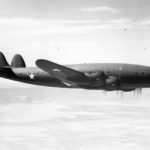Click on thumbnail images to enlarge
XC-69 NX25600 Constellation in flight
The prototype XC-69 Constellation over Wright Field
Lockheed XC-69 Constellation in flight
C-69 Constellation serial 43-10315 in flight 2
C-69 Constellation serial 43-10315 in flight
Maiden Flight of Lockheed XC-69 January 9, 1943
First Lockheed C-69 Constellation NX25600 on the ground
Lockheed C-69 NX25600 at Burbank
Military variant of the Lockheed L-049 Constellation.
General Specifications
- Type: Four-engined airliner.
Wings
- Configuration: Low-wing cantilever monoplane.
- Construction: All-metal structure with flush-riveted smooth stressed skin. Equipped with Lockheed-Fowler flaps for take-off, maneuvering, and landing. Features hot air de-icing.
Fuselage
- Structure: All-metal semi-monocoque with a circular cross-section. The fuselage has a cambered center-line, providing a longitudinal aerofoil shape and a maximum width for a level floor, especially in the nose and tail sections.
Tail Unit
- Configuration: Cantilever monoplane with triple fins and rudders.
- Construction: All-metal structure with hydraulic power-boost controls for reducing pilot effort, ensuring positive control with reduced fatigue. It also includes a manual override for auxiliary use.
Landing Gear
- Type: Retractable tricycle type with dual main wheels and a steerable nose wheel. Dual hydraulic brake systems with auxiliary manual override.
Power Plant
- Engines: Four 2,200 h.p. Wright R-3350 eighteen-cylinder radial air-cooled engines.
- Propellers: Hamilton-Standard Hydromatic quick-feathering airscrews, 15 ft. (4.57 m) in diameter.
- Features: Stainless steel engine nacelles with all ducting and controls grouped at the fireproof bulkheads, designed to be quickly detachable and interchangeable. The aircraft includes an automatic fire detection and location system with a positive fire-extinguisher system operated by the flight engineer. There are four separate fuel systems located in the wings.
Accommodation
- Crew Configuration: Pilot (left seat), co-pilot (right seat), flight engineer (behind co-pilot, facing outboard), and radio operator (behind pilot, facing forward). The navigator’s cabin and crew accommodations are located aft of the pilot’s compartment, with a bulkhead separating these spaces from the main passenger compartment.
- Passenger Cabin: The main compartment offers flexible arrangements for seating from 30 to 64 passengers in day and night configurations. Additional facilities include food lockers, cloakroom, lavatory, and cargo space beneath the floor. The cabin is pressurized, allowing operation up to 30,000 ft. (9,150 m) with sea level conditions maintained up to 10,000 ft. (3,050 m) and relative conditions equivalent to 8,000 ft. (2,440 m) to 12,000 ft. (3,660 m) between 25,000 ft. (7,625 m) and 30,000 ft. (9,150 m). The aircraft features two fully automatic cabin superchargers, thermostatically-controlled heating and cooling, full insulation against sound, vibration, and temperature, and infra-red windshield de-icers.
Dimensions
- Span: 123 ft. (37.5 m)
- Length: 95 ft. 11.3 in. (29 m)
- Height Over Fuselage: 18 ft. 8.3 in. (5.7 m)
- Overall Height: 23 ft. 8 in. (7.2 m)
Weights
- Empty Weight: 50,100-51,400 lbs. (22,745-23,335 kg)
- Operating Weight (including crew and passenger service equipment): 53,500-55,500 lbs. (24,290-25,200 kg)
- Maximum Take-Off Gross Weight: 86,250 lbs. (39,160 kg)
- Maximum Landing Gross Weight: 75,000 lbs. (34,050 kg)
Performance
- Maximum Speed (fully loaded): 340 mph (544 km/h)
- Cruising Speed (65% power): Over 300 mph (480 km/h)
- Landing Speed: 80 mph (128 km/h)
- Service Ceiling: Over 25,000 ft. (7,625 m)
- Range (with 20,000 lbs. = 9,080 kg payload): Over 2,000 miles (3,200 km)
- Take-off Run (fully loaded at sea level): 1,600 ft. (488 m)
- Take-off Run to Clear 50 ft. Obstacle (fully loaded): 2,800 ft. (854 m)
- Landing Run (full stop after clearing 50 ft. obstacle): 2,300 ft. (700 m)
Bibliography:
- Rene J. Francillon: Lockheed Aircraft Since 1913
- E.R. Johnson: American Military Transport Aircraft Since 1925
- Austin J. Brown: Lockheed Constellation
- Curtis K. Stringfellow, Peter M. Bowers: Lockheed Constellation: Design, Development, and Service History of all Civil and Military Constellations, Super Constellations, and Starliners
- Steve Pace: Lockheed’s Constellation – Enthusiast Color Series
- Claude G. Luisada: Queen of the Skies: The Lockheed Constellation
- Scott Germain: Lockheed Constellation & Super Constellation – Airliner Tech Volume 1
- Jim Winchester: Lockheed Constellation – Classic Airliners
- Holmes G. Anderson: The Lockheed Constellation, Aircraft Profile Number 120







